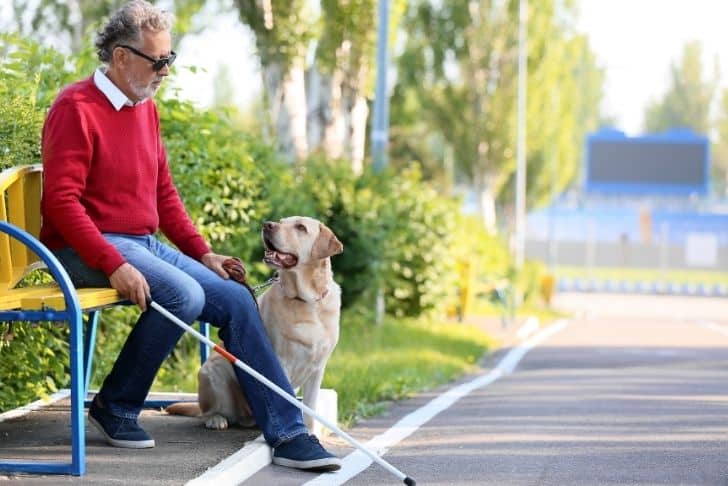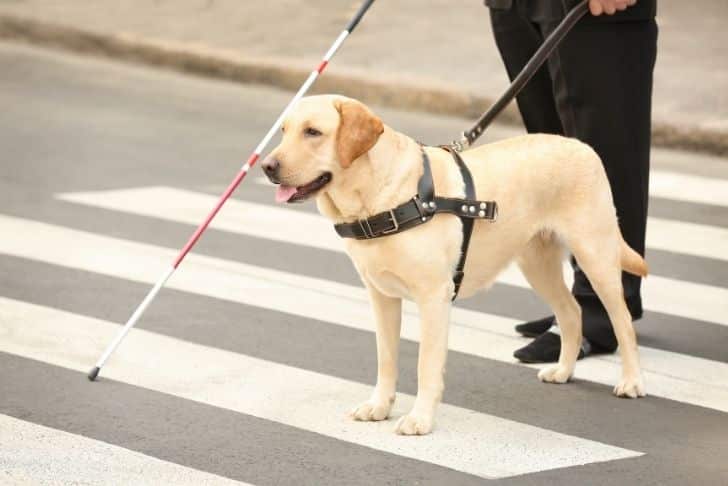Whether you’re navigating the challenges posed by an injury, disability, or simply the aging process, mobility aids can be life-changing tools. Imagine having the freedom and independence to move around with less discomfort and fear of stumbling or falling. In “Guide Dogs, Canes, and More: Types of Mobility Aids Explained”, you’ll learn all about the various mobility aids at your disposal. You’ll get to know how canes, crutches, walkers, and wheelchairs can not only help individuals who have difficulty walking, but also how these aids impact your body’s pressure points. We’ll also explore mobility scooters and their battery-powered convenience, and guide dogs who serve as invaluable aides to those with visual impairments.
Home or office safety modifications for creating a safer environment are also covered. Learning to use these aids properly can offer immense advantages to those with arthritis, cerebral palsy, other physical disabilities, as well as older adults and those healing from surgeries. However, it’s crucial to be aware of the potential risks to avoid injuries due to improper use. The illumination you’ll gain from this insightful read will empower you with a deeper understanding of mobility aids and the significant quality of life improvements they can offer.
Understanding Mobility Aids
General Definition of Mobility Aids
Mobility aids are devices specially designed to provide assistance to individuals who find it challenging to move around. These aids aim to provide a higher level of freedom, independence, and comfort to such individuals, enabling them to perform their daily tasks effortlessly.
The Importance of Mobility Aids
Mobility aids hold immense importance in positively influencing the quality of life for many people. They serve as a reliable support system for those having difficulty moving due to varying reasons such as orthopedic injuries, disabilities, or old age. These mobility aids are not merely tools for easier movement; they also boost self-esteem and confidence due to the independence they provide.
The Range of People Who Use Mobility Aids
People from very diverse backgrounds use mobility aids. Individuals with physical disabilities such as arthritis or cerebral palsy, people recovering from surgeries, and older adults who are at risk of falling find mobility aids highly beneficial. The purpose remains common – to enhance mobility in daily life.
The Benefits of Mobility Aids
Apart from just facilitating movement, mobility aids provide several additional benefits. They tend to reduce pain linked with putting weight on specific body parts. Moreover, the independence that comes with using mobility aids often results in increased confidence and self-esteem.
Common Types of Mobility Aids
General Overview of Different Types of Mobility Aids
Several types of mobility aids cater to varying needs and body strength. These may include canes, crutches, walkers, wheelchairs, mobility scooters, and guide dogs. The precise choice hinges on individual requirements and the level of mobility impairment.
Choosing the Right Type of Mobility Aid
Choosing the right type of mobility aid is vital as the incorrect selection might end up causing discomfort or even further impairments. It is indispensable to obtain professional medical advice when deciding on the most suitable mobility aid.

Insight into Canes
Main Function of Canes
Canes principally provide balance and support body weight, making them a great aid for people who have minor mobility problems. However, their usage requires good upper body strength and hand grip, as they exert more pressure on hands and wrists.
Different Types of Canes
Canes come in a variety of styles and designs, catering to different support and balance needs. The choice depends on the amount of weight they need to support and how often they will be used.
How to Properly Use a Cane
Proper usage of canes is crucial for avoiding secondary injuries. The cane should be at a comfortable height, reaching the wrist when your arm is hanging to the side. It’s typically used on the side opposite to your injury or weakness.
Potential Risks of Using Canes
While canes indeed deliver aid, improper usage could possibly cause discomfort or injury. It can lead to hand and wrist pain due to the pressure they endure.
Exploring the Use of Crutches
Functionality of Crutches
Crutches are primarily used to transfer all or some weight from the legs to the upper body. They help keep weight off your legs and allow you to move around with greater ease and safety.
Different Designs of Crutches
Crutches come in different designs ranging from underarm to forearm ones. Your healthcare professional will guide you towards the most suitable type considering your weight, height, and nature of mobility impairment.
How to Use Crutches Correctly
Correct usage is crucial in avoiding injuries. The height of the crutches should be adjusted in a way that allows you to maintain an upright posture, with your elbows slightly bent as you hold onto the handgrips.
Possible Risks Associated with Crutches Use
Improper utilisation of crutches can lead to adverse outcomes, such as crutch paralysis. This happens mainly due to excessive pressure on the underarm nerves.

Understanding Walkers or Zimmer Frames
Key Role of Walkers
Walkers play a key role in delivering ample support and stability. These devices consist of a metal framework with four legs, providing a broader base for easier movement.
Different Types of Walkers
Walkers come in a variety of sizes and designs, some of which incorporate wheels for easier mobility. Picking the right kind will depend on your physical needs and lifestyle.
Proper Way of Using Walkers
To use a walker, you should hold its grips and place it at a comfortable distance in front of you, then step forward, leading with your weaker leg.
Potential Complications of Walkers Use
Inaccurate height setting or improper use of walkers can lead to uneven body weight distribution, potentially causing falls and injuries.
Wheelchairs as a Mobility Aid
Primary Function of Wheelchairs
Wheelchairs serve as a perfect mobility aid for individuals who cannot put weight on their lower limbs or have a complete inability to walk.
Various Forms of Wheelchairs
Wheelchairs come in both manual and electric versions, with variations being incorporated to accommodate individual user needs.
How to Use a Wheelchair
Proper usage of a wheelchair involves having a good sitting posture, correctly using the armrests, footplates, and learning the correct pushing technique if using a manual wheelchair.
Possible Dangers of Wheelchair Use
Potential dangers include tipping over and muscle strain from improper use over time. Always ensure brakes are engaged when stationary to avoid accidents.
Mobility Scooters and How They Help
Main Purpose of Mobility Scooters
Mobility scooters, similar to wheelchairs but mounted on 3, 4 or 5 wheels, are designed to assist people with mobility issues. They involve lesser physical effort as they are typically battery-powered.
Different Kinds of Mobility Scooters
Mobility scooters vary in their design and functionality, ranging from compact, portable types to more robust, heavy-duty versions for rugged outdoor use.
How to Operate Mobility Scooters
Proper operation involves learning the controls carefully, including how to steer, accelerate, decelerate, and stop the scooter.
Potential Hazards of Using Mobility Scooters
Potential hazards include tipping over on uneven surfaces and the risk of collision if the controls are improperly managed.
Guide Dogs and Their Role in Enhancing Mobility
Defining Guide Dogs
Guide dogs, being a unique kind of mobility aid, are professionally trained service animals. They assist people who are blind or visually impaired, making navigation safer and more efficient.
Training of Guide Dogs
Guide dogs undergo rigorous training to adopt behaviours that are conducive for serving visually impaired individuals. This training equips them to navigate through various obstacles and environments confidently.
How Guide Dogs Assist People with Visual Impairments
Guide dogs immensely help in enhancing the mobility of people with visual impairments. They guide their handlers around obstacles, leading them towards their destination in a safe manner.
Possible Concerns Regarding Guide Dogs
Some potential concerns could include the initial cost of obtaining a guide dog, their grooming, and health maintenance over time but these are mostly outweighed by the significant benefits they deliver.

Modifications in Home or Office for Safer Mobility
Need for such Modifications
Modifications in homes or offices are beneficial for creating a safer, more navigable environment for people using mobility aids.
Types of Modifications
These modifications can include installation of ramps, stairlifts, handrails, and rearrangement of furniture to create wider passageways.
How These Modifications Improve Mobility
Such modifications cater to enhanced mobility by mitigating risks of slipping, tripping, or falling. They also assist in maneuvering mobility aids more efficiently.
Cost and Implementation of Modifications
While these modifications might involve some initial costs, their long-term benefits in terms of increased safety and convenience make them a worthy investment.
Risks and Proper Use of Mobility Aids
Various Risks Associated with Mobility Aids
While mobility aids provide numerous benefits, they come with some risks such as improper use leading to potential injuries. Therefore, understanding and abiding by correct usage guidelines is essential.
Critical Role of Proper Use to Minimize Risks
Proper usage of mobility aids is a critical factor in avoiding risks. All aids come with an instruction manual which should be thoroughly understood and followed.
Getting Guidance from Healthcare Professionals
Always consult healthcare professionals for guidance on selecting the right mobility aid and to learn how to properly use it. Their expert advice helps in maximizing the benefits of mobility aids while minimizing associated risks and complications.
